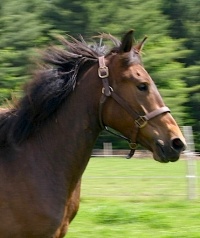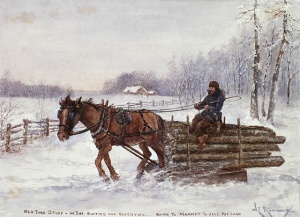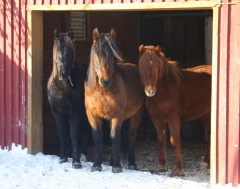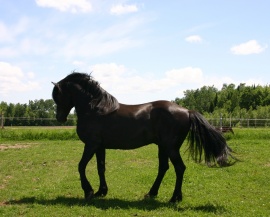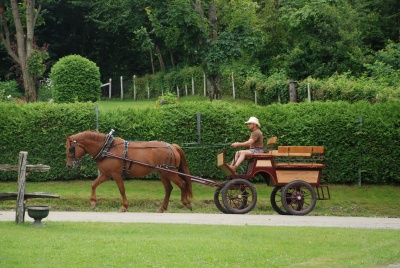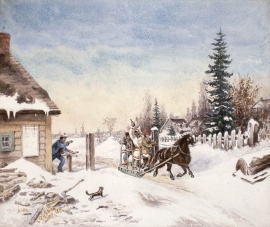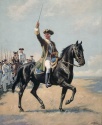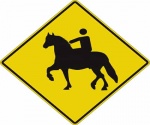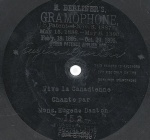Canadian Horse: a Quebec Agricultural Treasure
par Lambert, Gérard and Rowe, Sandra
The Province of Quebec is the cradle of North America's oldest equine breed: the Canadian Horse. Since the end of the 19th century, this heritage horse breed, also known as the "French Canadian Horse" or "Little Iron Horse," has been the objective of many conservation initiatives, including efforts to create a detailed listing of its distinct characteristics, as well establishing organizations for assuring the continuity of the breed. Since 1999, it has been recognized at the provincial level as a Quebec agricultural heritage breed, joining the ranks of the Canadienne Cow and the Chantecler Chicken. It was named the National Horse of Canada by the Canadian parliament in 2002. In 2007 it became an archetypal icon in the Province of Quebec, when the Transport Ministry ruled to include it as an official road sign pictograph, as a part of its tourist signing policy.
Article disponible en français : Cheval Canadien, joyau du patrimoine agricole du Québec
The History of the Breed
The first ancestral stock of what is now known as the Canadian Horse arrived in New France (today the Province of Quebec) in July 1665, directly from the stud farm of the King of France, Louis the 14th. According to historians, no horses of any kind were to be found north of Mexico at that time. The initial breeding stock included a pair of stallions and 12 mares, several other shipments were sent between 1667 and 1670.
These first arrivals were delivered to the colony's governors, ruling-class and religious communities. Because of the fertility of Canadian mares, which are capable of bearing foals beyond the age of 20 years old, the breed's numbers increased by leaps and bounds. Thus, by 1671, the King's Chief Steward, Jean Talon, had already written to Louis the 14th to explain that no more shipments would be required since there were enough horses in New France to meet the colony's needs.
As their numbers grew, certain horses were given to farmers. Although they would remain the property of the King of France for another three years, just until the farmer-whose duty was to ensure that the mare would foal-handed over the first foal to the Chief Steward in exchange for property rights to the mare. In 1763, with the signing of the Treaty of Paris and the transfer of the colony to England, there were 14,000 Canadian Horses in New France. The breed's population would continue to grow rapidly, reaching 24,000 by 1784.
The Canadian Horse reproduced in isolation for quite a long time, at least up until the conquest of 1760. At the time, living conditions were quite extreme; the harshness of the climate and the limited availability of resources meant that only the fittest survived to assure the continuity of the breed. The breeding stock diminished in size and acquired certain very specific characteristics that it has retained to this day. The Canadian Horse was used for farm work, freight hauling, family travel, public transit and even horse racing. At the beginning of the 19th century, it was considered the best stagecoach horse due to its speed and endurance, as well as its courage in extreme situations. All of these qualities earned it the nickname "Little Iron Horse."
It wasn't long before the breed came to be recognized as the best in North America and rapidly became the envy of the neighbours to the south. In the latter third of the 18th century, the Canadian Horse, already well known in Nova Scotia and New Brunswick, was exported to the United States. There, it would be bred to create or improve breeds such as the Morgan, the Standardbred, the American Saddlebred, and a number of others. This small sturdy horse also played a major role in the development of both Lower Canada (the Province of Quebec) and Upper Canada (Ontario).
By the mid-19th century, this horse, which had hitherto been so popular and the envy of all, began to dwindle in numbers, for not only were substantial numbers being exported, but also large numbers of foreign breeds were being imported and mechanized shipping and hauling using boats and steam trains was on the rise. This unsettling trend became so widespread that, by the end of the 19th century, government officials began to worry about the future of the breed.
Conservation Efforts
In 1885, the Government of Quebec, under the direction of Dr. J. A. Couture, tried to take measures to stop this decline by establishing a commission for examining the remaining Canadian Horses in order to register them in genealogical ledger known as a stud book, officially published on December 16, 1886. Progress was slow at first, but in 1895, the Canadian Horse Breeders' Association (CHBA) was founded. A few years later, a new stud book, which included breeding standards for the Canadian Horse, was published under the auspices of the federal government and its commissioner, Dr. J. G. Rutherford.
In hopes of regulating, stabilizing and protecting breeding stock, Dr. Rutherford and the federal department of agriculture established standards for the Canadian Horse:
Stallions must not exceed 15.3 hh, and weighing 1100-1350 lbs. Mares must not exceed 15.2 hh, and weighing 1050-1250 lbs. The head is courageous looking, perhaps somewhat angular, with the ears far apart, the neck thick, the frame stout, the breast full, the shoulders strong, even rather upright, the back longer than short and sides inclined to flatness, the croup rather round or fleshy with quarters short and somewhat drooping, the muscles well let down and the tendons large, the feet tough and almost immune from disease.
Although the Canadian Horse has no fixed colour, it is generally black, brown, chestnut or bay.
Six years later, in 1907, the federal department of agriculture established its own conservation program to raise Canadian Horses in Cap Rouge (Quebec City), where Cap-Rouge Albert, a stallion of great importance for the breed, was reared. The federal government pursued this breeding program, involving over 40 horses, until 1940 when the Second World War brought it to an end. At this point, the Quebec government was keen to take over the reins, so it purchased a number of the horses and continued to breed them at the Deschambault experimental farm. In November 1981, the horses were all auctioned off to member breeders of the Canadian Horse Breeders' Association. (NOTE 1) At this point, there were fewer than 400 Canadian Horses left.
"Preserving for Our Children, the Horse of Our Forefathers"
Founded in 1998, the non-profit Association Québécoise du Cheval Canadien [Quebec Canadian Horse Association] (AQCC), has the mission of protecting and improving the Canadian Horse breed in accordance with original standards, as they are described in volume one of the CHBA's stud book. Its motto is "Preserving for our children the horse of our forefathers."
The AQCC has the objective of bringing Quebec's Canadian Horse breeders and owners together, as well as all those interested in the breed's heritage. Furthermore, it represents association members before any authority likely to assist with promoting the breed and it also organizes various activities showcasing the Canadian Horse, particularly Canadian Horse Day and the Little Iron Horse Competition. (NOTE 2) The AQCC also organizes courses on equine genetics, harnessing and saddling, as well as publishing information promoting the history of the breed.
In spite of all the efforts of devoted Canadian Horse breeders from all over the country, the breed is still in danger of disappearing and considered at risk, particularly by Rare Breeds Canada.
The Canadian Horse: Our Heritage
Today, it is possible to find the Canadian Horse in every Canadian province and they are the pride and joy of their owners. Horse admirers can find examples of the breed in Ontario's Upper Canada Village, Nova Scotia's Ross Farm Museum and Sherbrooke Village, and New Brunswick's Acadian Village and Kings Landing Historical Settlement. In Quebec, to see the breed, one should particularly go to Drummondville's Village Québécois d'Antan [A Quebec Village of Yesteryear) and to the Site de la Nouvelle France in St-Félix d'Otis in the Saguenay region.
Over the last few decades, the Canadian Horse has ranked among the world's best in harness competitions and sometimes it has even earned first prize. This sturdy little shaggy-maned horse with thick tail was the pride and joy of our forefathers and hopefully will remain so for future generations to come. In 1999, the Quebec government recognized its contribution to the growth and development of the region by naming it Cheval Patrimonial du Québec [Quebec heritage horse] and the Canadian parliament followed suit in April 2002 by designating it the National Horse of Canada.
In spite of all these honours, public awareness of the breed is still somewhat limited in the country of its birth. When people first see this proud, vivacious little horse, they are surprised and often ask, "What kind of horse is this?" And its owner will proudly reply: "A Canadian!"
Sandra Rowe
Association québécoise du cheval canadien (AQCC)
Gérard Lambert, President of the Syndicat d'Élévage National du Cheval Canadien-Français (SENCCF)
NOTES
NOTE 1: The CHBA was founded in 1895. Its headquarters are in Quebec. The association's members do not have a strategy for selecting the best breeders.
NOTE 2: Canadian Horse Day includes Futurities [a horse race or competition in which the competitors are nominated at birth or before OR entries to the competition made well in advance], the Little Iron Horse Competition - Junior (three categories) and the Little Iron Horse Competition (five categories). All categories of the LIH Competition are saddle and harness competitions.
BIBLIOGRAPHY
BERNIER, Paul, Le cheval canadien, Québec, Septentrion, 1992, 168 pages.
Additional DocumentsSome documents require an additional plugin to be consulted
Images
-
 Deux habitants, l'un
Deux habitants, l'un
avec un cheval,... -
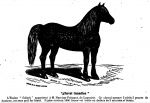 Goliath, étalon de la
Goliath, étalon de la
race Canadien,... -
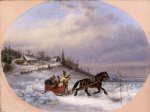 Habitants en carriole
Habitants en carriole
, vers 1856 -
 Le cheval canadien
Le cheval canadien
Document sonore
Documents PDF
-
 « Des encouragements à la production du cheval »
« Des encouragements à la production du cheval »
-
 «Notre petit cheval canadien»
«Notre petit cheval canadien»
-
 Loi sur le cheval national du Canada
Loi sur le cheval national du Canada
-
 Loi sur les races animales du patrimoine agricole du Québec
Loi sur les races animales du patrimoine agricole du Québec
-
 Texte décrivant les meilleures conditions d'élevage des chevaux canadiens
Texte décrivant les meilleures conditions d'élevage des chevaux canadiens
Hyperliens
- Dr. J.-A. Couture on the Dictionary of Canadian Biography Online
- Association québécoise du cheval canadien (AQCC) [French]

